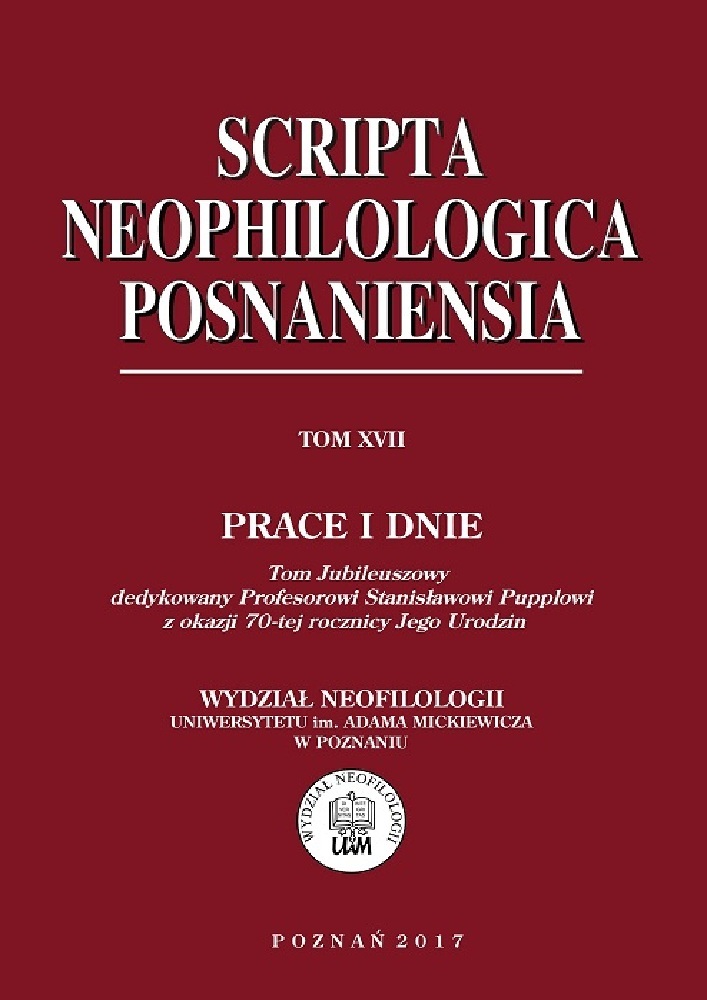Abstrakt
Cosmopolitan Berlin? Interpreting the linguistic landscape of a cosmopolitan cityBibliografia
Backhaus, P. 2006. “Multilingualism in Tokyo: a look into the linguistic landscape”. In: Gorter, D. (ed.). Linguistic landscape: a new approach to multilingualism. Clevedon: Multilingual Matters, Ltd. 52-66.
Beck, U. and N. Sznaider. 2006. “Unpacking cosmopolitanism for the social sciences: a re-search agenda”. British Journal of Sociology. 57. 1–23.
Ben-Rafael, E., Shohamy, E., Amara, M.H. and N. Trumper-Hecht. 2006. “Linguistic land-scape as symbolic construction of the public space: the case of Israel”. In: Gorter, D. (ed.). Linguistic landscape: a new approach to multilingualism. Clevedon: Multilingual Matters, Ltd. 7-30.
Ben-Rafael, E. 2009. “A sociological approach to the study of linguistic landscapes”. In: Shohamy, E. and D. Gorter (eds.). Linguistic landscape: expanding the scenery. New York: Routledge. 40-54.
Cenoz, J., and D. Gorter. 2006. “Linguistic landscape and minority languages”. In: Gorter, D. (ed.). Linguistic landscape: a new approach to multilingualism. Clevedon: Multilingual Matters. 67-80.
Göktürk, D., Gramling D., and A. Kaes. (eds.). 2007. Germany in transit: nation and migration 1955–2005. Berkeley: University of California Press.
Grześkowiak, M. 2010. Trans-city or inter-city? The co-existance of majority and minority languages in the urban space: a comparative case study of London and Warsaw linguistic landscapes. Poznań: Katedra Ekokomunikacji UAM.
Hornberger, N. 2003. “English in the global ecology of languages: the value of multilingual-ism”. BESIG Business Issues 2. 2-6.
House, J. 2003. “English as a lingua franca: a threat to multilingualism?” Journal of Sociolin-guistics. 7.4. 556-578.
Papen, U. 2012. “Commercial discourses, gentrification and citizens’ protest: the linguistic landscape of Prenzlauer Berg, Berlin”. Journal of Sociolinguistics 16.1. 56-81.
Pavlenko, A. 2009. “Language conflict in Post-Soviet linguistic landscapes”. Journal of Slavic Linguistics 17.1-2. 247-274.
Puppel, S. 2007. “Interlingwalizm czy translingwalizm? Interkomunikacja czy transkomuni-kacja? Uwagi w kontekście współistnienia języków naturalnych w ramach globalnej wspólnoty kulturowo-językowo-komunikacyjnej”. In: Puppel, S. (ed.). Społeczeństwo - kultura - język. Poznań: Katedra Ekokomunikacji UAM. 86-108.
Sandercock, L. 2003. Cosmopolis II. Mongrel cities of the 21st century. London and New York: Continuum.
Shohamy, E. and S. Waksman. 2009. “Linguistic landscape as an ecological arena: modalities, meanings, negotiations, education”. In: Shohamy, E. and D. Gorter (eds.). Linguistic landscape: expanding the scenery. New York: Routledge. 313-331.
Spolsky, B. and R.L. Cooper. 1991. The languages of Jerusalem. New York: Oxford University Press.
Spolsky, B. 2009. “Progelomena to a sociolinguistic theory of public signage”. In: Shohamy, E. and D. Gorter (eds.). Linguistic landscape: expanding the scenery. New York: Routledge. 25-39.
